Effect of Al2O3 on Inclusion Removal in H13 Steels Using High-Basicity LF (Ladle Furnace) Refining Slags
Abstract
:1. Introduction
2. Materials and Methods
2.1. Slag-Steel Equilibrium Experiment
2.2. Experimental Analysis Methods
3. Results and Discussion
3.1. Morphologies and Compositions of the Inclusions
3.2. Numbers and Sizes of Inclusions
3.3. Compositions and Plasticities of the Steel Inclusions
3.4. Steel-Slag-Inclusion Reaction
4. Conclusions
- (1)
- As the slag basicity and the CaO/Al2O3 ratio increased, the densities of the inclusions decreased, and the sizes of the inclusions in the steel decreased with increasing the slag basicity. When the slag basicity was constant, the sizes of the inclusions decreased with increasing the CaO/Al2O3 ratio, and then they increased. Overall, the best control effect on the inclusion density and size was achieved when the slag basicity was 6 and the CaO/Al2O3 ratio was 2.1. The inclusion density was 25 per mm2, and the size could reach 1.15 μm.
- (2)
- By comparing the average contents of each component in the inclusions in the steel samples, it was found that the variations in the CaO, Al2O3, SiO2, and MgO contents in the inclusions were consistent with the variations in the CaO, Al2O3, SiO2, and MgO contents in the refining slag. The Al2O3 contents in the slag increased with increasing the slag basicity, and they decreased with increasing the CaO/Al2O3 ratio. According to the calculated results, reducing the Al2O3 contents in the slag and inclusions was beneficial for reducing the moduli of elasticity of the inclusions and improving their abilities for elastic deformation. With the increases in slag basicity, the moduli of elasticity of the inclusions showed an increasing trend.
- (3)
- In combining the experimental results and calculation analysis, it was found that with the increases in the CaO/Al2O3 ratios in the slag system, the Al contents in the steel melt decreased, and the masses of the inclusions decreased. The Al contents in the steel melt also affected the compositions of the inclusions. With the increases in the Al contents in the steel melt, the Al2O3 contents in the inclusions increased from 39% to 62% while the SiO2 contents decreased from 20% to 11%. The CaO contents initially increased from 12% to 17% with increasing the Al contents, and then they decreased to 11%. The MgO contents initially decreased from 26% to 18% and then increased to 20% with increasing the Al contents.
Author Contributions
Funding
Data Availability Statement
Acknowledgments
Conflicts of Interest
References
- Wegener, T.; Krochmal, M.; Möller, T.R.; Le, M.T.; Czap, A.; Marianek, F.; Fakesch, H.; Niendorf, T. On the low-cycle fatigue behavior of a novel high strength mold steel. Int. J. Fatigue 2023, 175, 107754. [Google Scholar] [CrossRef]
- Zhou, Y.; Chen, L.; Jiang, W.; Cui, S.; Cui, X. Investigation on elevated-temperature wear performance and wear failure mechanism of a tungsten-system hot-working die steel. Surf. Topogr. Metrol. Prop. 2022, 10, 035007. [Google Scholar]
- Li, X.; Jiang, Z.; Geng, X.; Chen, M.; Peng, L. Evolution mechanism of inclusions in H13 steel with rare earth magnesium alloy addition. ISIJ Int. 2019, 59, 1552–1561. [Google Scholar] [CrossRef]
- Jiang, Q.C.; Sui, H.L.; Guan, Q.F. Thermal fatigue behavior of new type high-Cr cast hot work die steel. ISIJ Int. 2004, 44, 1103–1107. [Google Scholar] [CrossRef]
- Fuchs, D.; Tobie, T.; Stahl, K. Challenges in determination of microscopic degree of cleanliness in ultra-clean gear steels. J. Iron Steel Res. Int. 2022, 29, 1583–1600. [Google Scholar] [CrossRef]
- Sahai, Y. Tundish technology for casting clean steel: A review. Metall. Mater. Trans. B 2016, 47, 2095–2106. [Google Scholar]
- Wang, Z.; Guan, Y.H.; Luo, H.W. Progress on statistical models of evaluating inclusions in clean steels. J. Iron Steel Res. Int. 2022, 29, 1153–1163. [Google Scholar]
- Tridello, A.; Paolino, D.S.; Chiandussi, G.; Rossetto, M. VHCF strength decrement in large H13 steel specimens subjected to ESR process. Procedia Struct. Integr. 2016, 2, 1117–1124. [Google Scholar]
- Liu, X.; Yang, J.; Zhang, F.; Fu, X.; Li, H.; Yang, C. Experimental and DFT study on cerium inclusions in clean steels. J. Rare Earths 2021, 39, 477–486. [Google Scholar]
- Mapelli, C. Control and engineering of non-metallic inclusions belonging to xsio(2)center dot ycao center dot zal(2)o(3) system in ca-treated al-killed and al-si-killed steel. Steel Res. Int. 2006, 77, 462–471. [Google Scholar]
- Krajnc, L.; Burja, J.; Medved, J.; Kim, T.S.; Park, J.H. Formation behaviour of spinel-cas multiphase inclusions in ca-treated resulphurised steel during the ladle furnace process. Mater. Tehnol. 2020, 54, 559–565. [Google Scholar] [CrossRef]
- Xiao, G.H.; Dong, H.; Wang, M.Q.; Hui, W.J. Hot deformability of oxide-sulfide duplex inclusions in calcium-treated gear steels. Beijing Keji Daxue Xuebao/J. Univ. Sci. Technol. Beijing 2010, 32, 735–738. [Google Scholar]
- Gollapalli, V.; Rao, M.B.V.; Karamched, P.S.; Borra, C.R.; Roy, G.G.; Srirangam, P. Modification of oxide inclusions in calcium-treated al-killed high sulphur steels. Ironmak. Steelmak. 2018, 46, 663–670. [Google Scholar] [CrossRef]
- Li, Y.; Yang, H.; Jiang, Z.H.; Li, H.B.; Sun, M.; Ma, S. Change of Spinel in High Ca Treament at 38CrMoAl Steel. ISIJ Int. 2022, 62, 2276–2285. [Google Scholar] [CrossRef]
- Wang, Y.; Sun, X.; Zhang, L.; Ren, Y. Effect of calcium treatment on inclusions in Si-Mn-killed 304 stainless steels. J. Mater. Res. Technol. 2020, 9, 11351–11360. [Google Scholar] [CrossRef]
- Sun, H.; Yang, J. Evolution behaviour and modification mechanism of inclusions in NM500 wear-resistant steel with calcium treatment. Ironmak. Steelmak. 2022, 49, 795–812. [Google Scholar] [CrossRef]
- Wang, W.; Zhang, L.; Luo, Y.; Ren, Y.; Sun, X. Transformation of inclusions in Al-killed steels with different calcium contents during the heat treatment. Ironmak. Steelmak. 2022, 49, 472–483. [Google Scholar] [CrossRef]
- Bielefeldt, W.V.; Vilela, A.C.F. Computational thermodynamic study of inclusions formation in the continuous casting of SAE 8620 steel. Steel Res. Int. 2010, 81, 1064–1069. [Google Scholar] [CrossRef]
- Guo, J.; Cheng, S.S.; Cheng, Z.J. Characterics of Deoxidation and Desulfurization during LF Refining Al-killed Steel by Highly Basic and Low Oxidzing Slag. J. Iron Steel Res. Int. 2014, 21, 166–173. [Google Scholar] [CrossRef]
- Liu, J.; Li, B.; Jia, Y.; Chen, J.; Feng, J.; Ren, B.; Gong, D. Slag resistance mechanism of CaO 6Al2O3 refractory and its effect on inclusions of aluminum deoxidized steel. Int. J. Appl. Ceram. Technol. 2022, 19, 3323–3333. [Google Scholar] [CrossRef]
- Wang, Y.; Yang, S.; Li, J.; Wang, F.; Gu, Y. Cyclic use of ladle furnace refining slag for desulfurization. J. Sustain. Metall. 2017, 3, 274–279. [Google Scholar] [CrossRef]
- Zhang, H.; Liu, C.; Lin, Q.; Wang, B.; Liu, X.; Fang, Q. Formation of plastic inclusions in U71Mnk high-speed heavy-rail steel refined by Cao-Si2-Al2O3-MgO slag. Metall. Mater. Trans. B 2019, 50, 459–470. [Google Scholar] [CrossRef]
- Wu, Z.; Li, J.; Shi, C.; Du, G. Effect of MgO content in slag system on inclusions in magnesium aluminum iron alloy deoxygenated H13 steel. Mech. Eng. Mater. 2015, 39, 5–10. [Google Scholar]
- Zhang, R.; Zhang, Z. Research and Application of Desulfurization in LF Refining Furnace at Taigang Steelmaking Plant. In Proceedings of the 2009 Shandong Metallurgical Society Steelmaking Academic Exchange Conference, Shandong, China, 1 September 2009; pp. 112–114. [Google Scholar]
- Li, Y.; Liu, M.; Liu, X. Production Process Practice of H13 Mold Steel Ingots. In Proceedings of the 2009 Shandong Metallurgical Society Steelmaking Academic Exchange Conference, Shandong, China, 1 September 2009; pp. 28–30. [Google Scholar]
- Huang, T.; Bi, S.; Zhang, W. LF+VD Outside Furnace Refining Technology for Clean Steel Production. In Proceedings of the 2012 Steelmaking Continuous Casting High Quality Clean Steel Production Technology Exchange Conference, Liaoning, China, 1 September 2012; pp. 66–70. [Google Scholar]
- Yang, W.; Wang, S.; Yun, X. Analysis and Research on the Resource Utilization of LF Furnace Refining Slag. In Proceedings of the 2021 Science and Technology Annual Meeting of the Chinese Society for Environmental Sciences (II), Tianjin, China, 19 October 2021; pp. 711–718. [Google Scholar]
- Yang, H.; Su, L.; Li, G.; Chen, Z.; Pi, C.; Zhou, Y. The effect of refining slag on inclusions in SUS444 ferritic stainless steel. Steelmaking 2014, 30, 42–4651. [Google Scholar]
- Ruan, X.; Jiang, Z.; Gong, W.; Li, Y.; Li, J. The effect of refining slag on oxygen content and inclusions in bearing steel. Spec. Steel 2008, 29, 1–3. [Google Scholar]
- Wang, Y.; Fu, G.; Li, Z. Research on the effect of high basicity refining slag on the inclusion characteristics of GCr15 bearing steel. Hebei Metall. 2018, 12, 13–16. [Google Scholar]
- Yu, H.; Qiu, G.; Hao, L.; Zhao, Y.; Wang, X. Refining slag Al2O3 Effect of Content on Inclusions in Aluminum Deoxidized Steel. Steelmaking 2023, 39, 18–23. [Google Scholar]
- Ji, Y.; Liu, C.; Lu, Y.; Yu, H.; Huang, F.; Wang, X. Effects of FeO and CaO/Al2O3 ratio in slag on the cleanliness of Al-killed steel. Metall. Mater. Trans. B 2018, 49, 3127–3136. [Google Scholar] [CrossRef]
- Ma, W.J.; Bao, Y.P.; Wang, M.; Zhao, D.W. Influence of slag composition on bearing steel cleanness. Ironmak. Steelmak. 2014, 41, 26–30. [Google Scholar] [CrossRef]
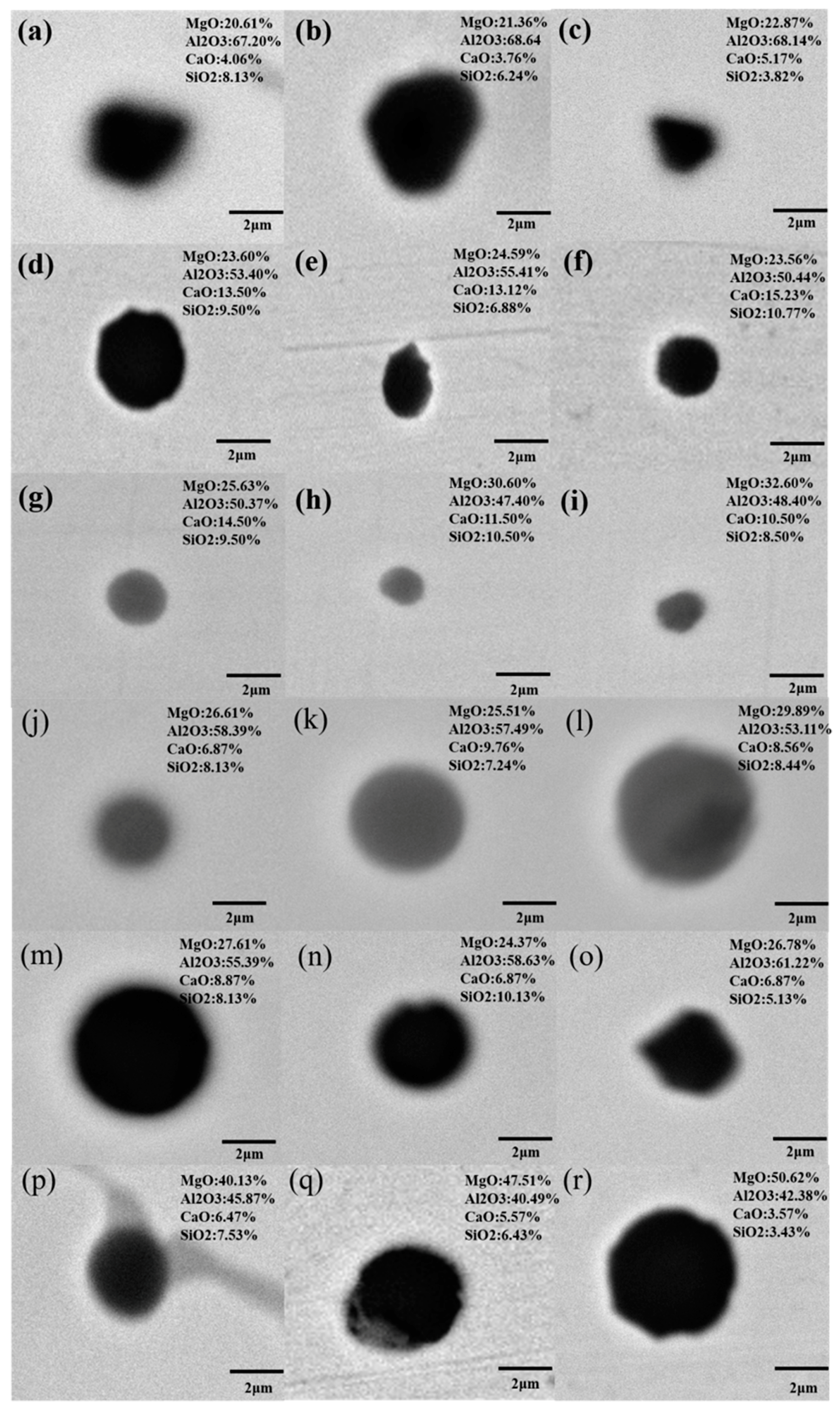

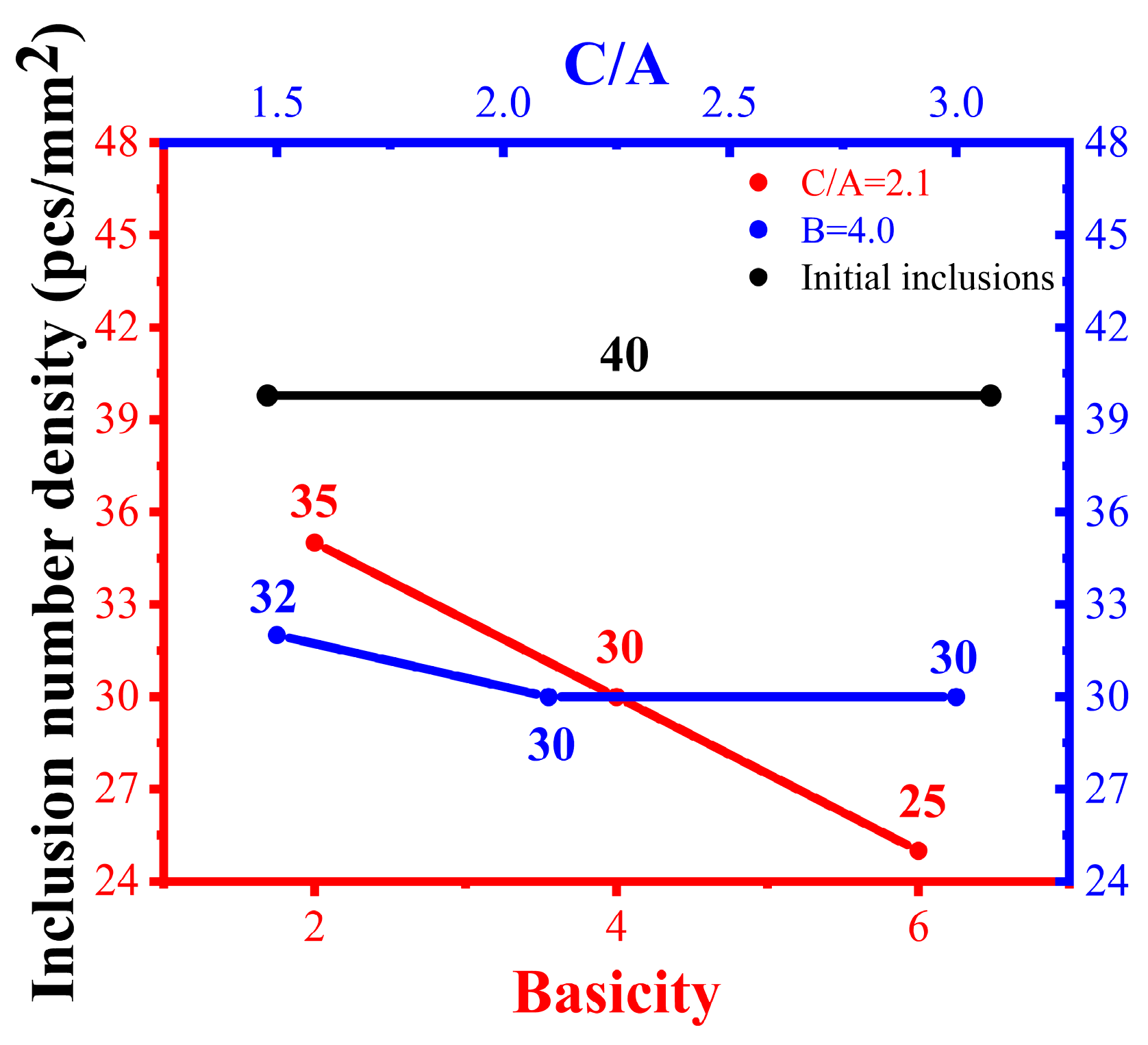

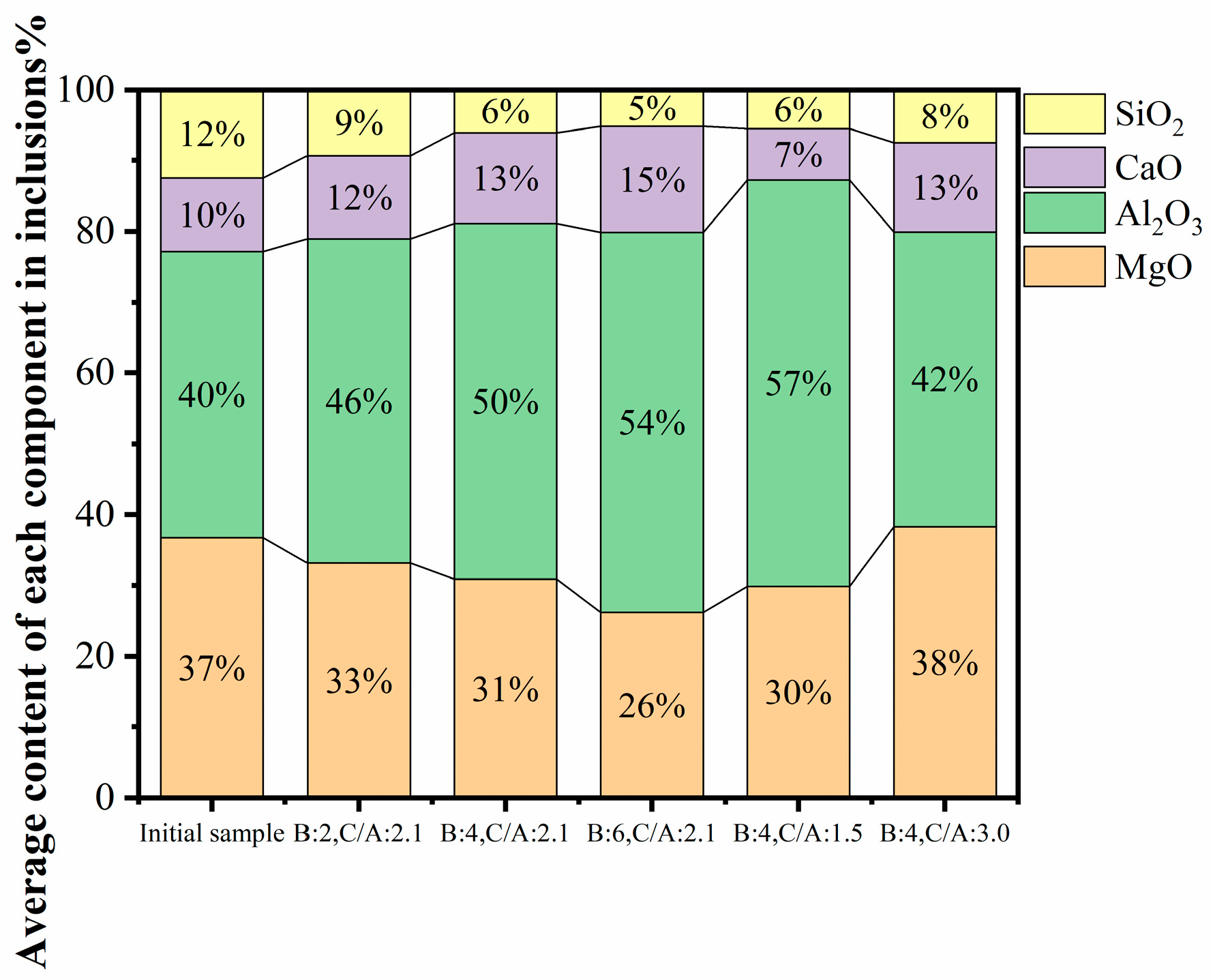
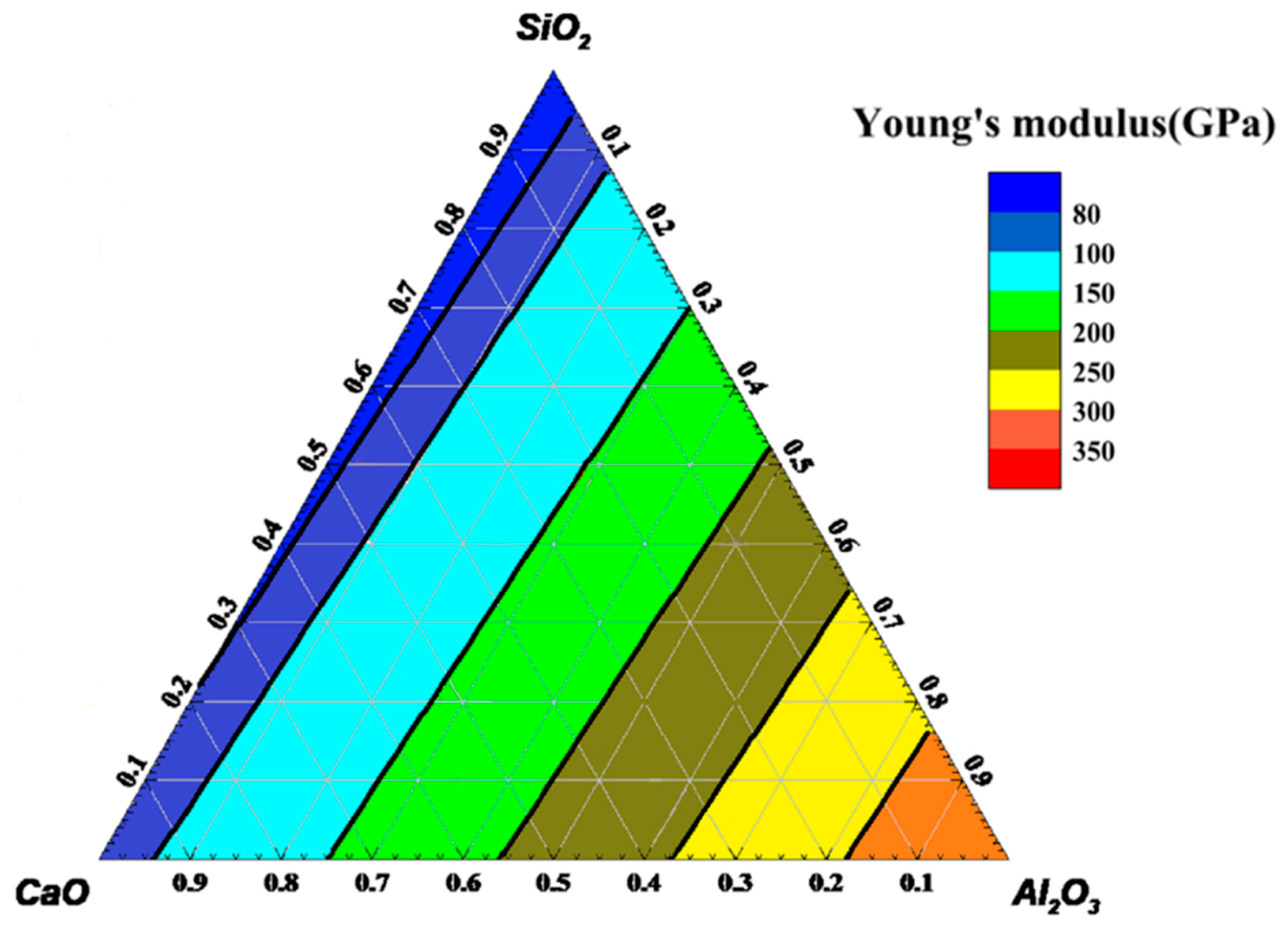
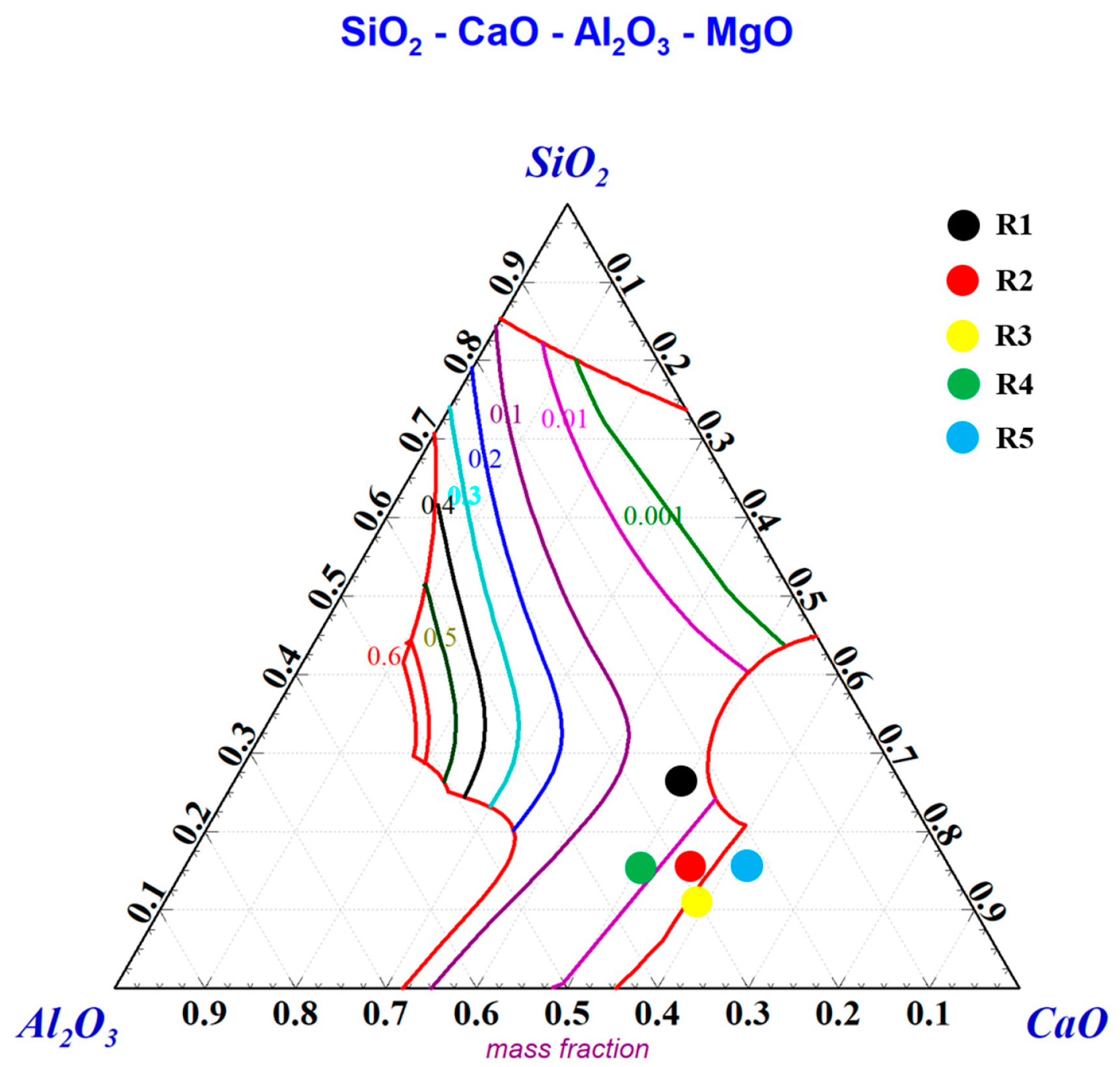
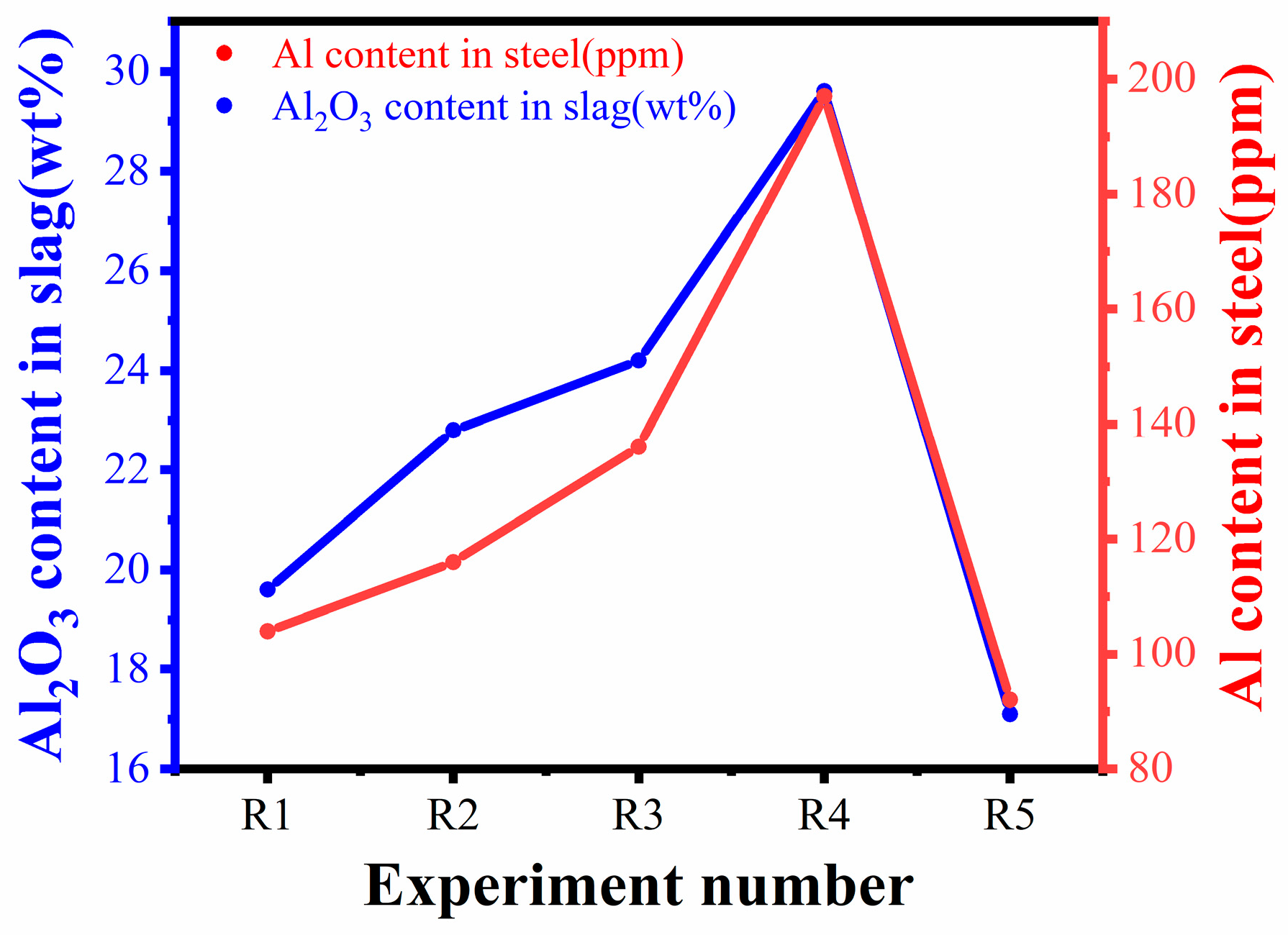

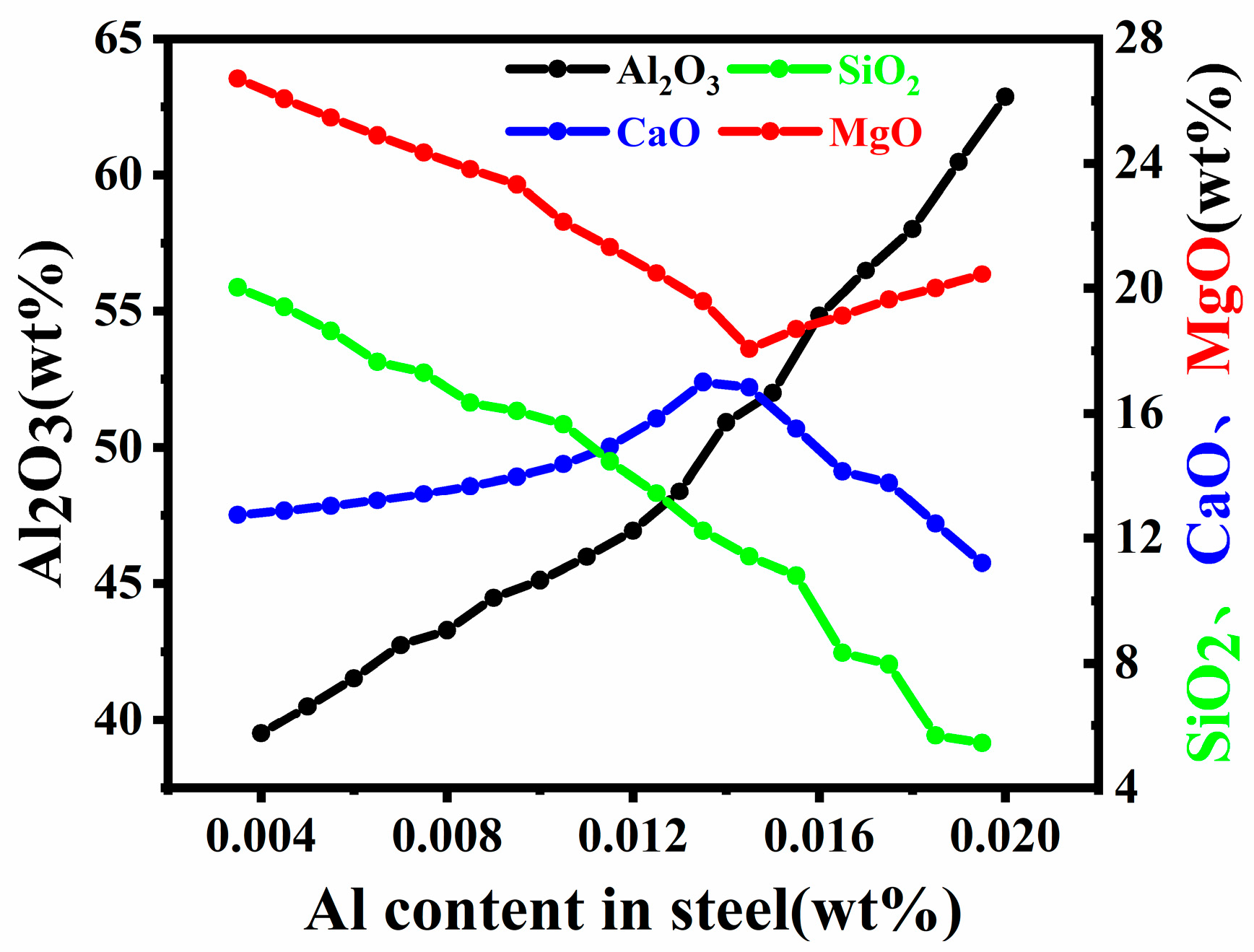
| Element | C | Cr | Mo | Si | Al | N | O |
| Content (%) | 0.489 | 5.367 | 1.521 | 0.952 | 0.004 | 0.0076 | 0.0022 |
| Element | P | Mn | Mg | V | S | ||
| Content (%) | 0.001 | 0.364 | 0.001 | 0.96 | 0.0023 |
| Experiment Number | CaO | SiO2 | Al2O3 | MgO | Basicity | C/A |
|---|---|---|---|---|---|---|
| R1 | 47.6 | 23.8 | 22.6 | 6 | 2.0 | 2.1 |
| R2 | 54.4 | 13.6 | 26.0 | 6 | 4.0 | 2.1 |
| R3 | 57.2 | 9.5 | 27.3 | 6 | 6.0 | 2.1 |
| R4 | 49.0 | 12.3 | 32.7 | 6 | 4.0 | 1.5 |
| R5 | 59.3 | 14.8 | 19.9 | 6 | 4.0 | 3.0 |
| Experiment Number | R1 | R2 | R3 | R4 | R5 |
|---|---|---|---|---|---|
| Al content | 104 | 116 | 136 | 197 | 92 |
Disclaimer/Publisher’s Note: The statements, opinions and data contained in all publications are solely those of the individual author(s) and contributor(s) and not of MDPI and/or the editor(s). MDPI and/or the editor(s) disclaim responsibility for any injury to people or property resulting from any ideas, methods, instructions or products referred to in the content. |
© 2023 by the authors. Licensee MDPI, Basel, Switzerland. This article is an open access article distributed under the terms and conditions of the Creative Commons Attribution (CC BY) license (https://creativecommons.org/licenses/by/4.0/).
Share and Cite
Liang, T.; Qin, Z.; Wang, L. Effect of Al2O3 on Inclusion Removal in H13 Steels Using High-Basicity LF (Ladle Furnace) Refining Slags. Metals 2023, 13, 1592. https://doi.org/10.3390/met13091592
Liang T, Qin Z, Wang L. Effect of Al2O3 on Inclusion Removal in H13 Steels Using High-Basicity LF (Ladle Furnace) Refining Slags. Metals. 2023; 13(9):1592. https://doi.org/10.3390/met13091592
Chicago/Turabian StyleLiang, Ting, Zhuo Qin, and Linzhu Wang. 2023. "Effect of Al2O3 on Inclusion Removal in H13 Steels Using High-Basicity LF (Ladle Furnace) Refining Slags" Metals 13, no. 9: 1592. https://doi.org/10.3390/met13091592
APA StyleLiang, T., Qin, Z., & Wang, L. (2023). Effect of Al2O3 on Inclusion Removal in H13 Steels Using High-Basicity LF (Ladle Furnace) Refining Slags. Metals, 13(9), 1592. https://doi.org/10.3390/met13091592






